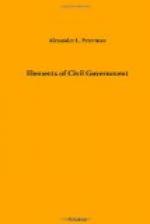SUGGESTIVE QUESTIONS.
1. In what respect does civil government differ from family or school government?
2. Why does the government of the civil district concern its people directly and others remotely?
3. What is meant by the civil unit? By what names is it known in the various States?
4. What are the three general classes under which the civil unit may be considered?
5. Why can not free government exist without the right to vote?
6. Why should the people try to secure their rights through the law?
7. What is the purpose of the subdivision of a county into districts?
8. Define in general terms the rights and duties of the citizens of civil districts.
9. By what other names are justices of the peace sometimes called?
10. Why is the jurisdiction of a justice’s court limited?
11. Who are the justices of this civil district?
12. When elected, and what is their term of office?
13. Who is constable of this district?
QUESTION FOR DEBATE.
Resolved, That the government of the civil district should have a legislative department.
CHAPTER IV.
THE TOWNSHIP OR TOWN.
INTRODUCTION.—We have learned that in the Southern States the civil unit under various names may be described under the common name of the civil district; that in the New England States it is called the town, and in many of the Western States it is known as the township. As the powers and functions of the town and the township are the same in kind, differing only in extent, and as the two names are so often used, the one for the other, we shall consider both under the head of the township.
As a rule, the township possesses more extensive governmental functions in the Eastern than in the Western States, and in the West it possesses functions much more extensive than those of the civil district in the South. Many of the most important powers that belong to the county in the Southern States belong to the township in the Eastern and the Western States.
FORMATION.—In the Eastern States the townships were formed in the first settlement of the country, and afterward a number of townships were combined to form the county. In the Western States the townships were surveyed, and their boundaries marked, by agents of the general government, before the Territories became States of the Union. As a natural result, the townships of the Eastern States are irregular in shape and size, while those of the Western States have a regular form, each being about six miles square. In the Western States the township is usually composed of thirty-six sections, each section being one mile square, and containing six hundred and forty acres of land.




